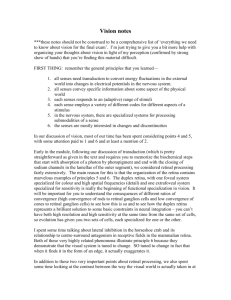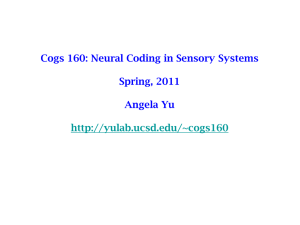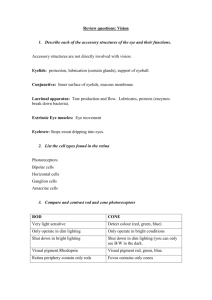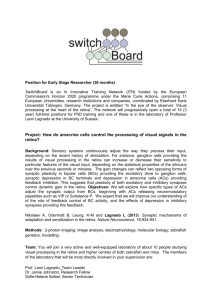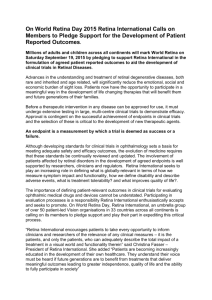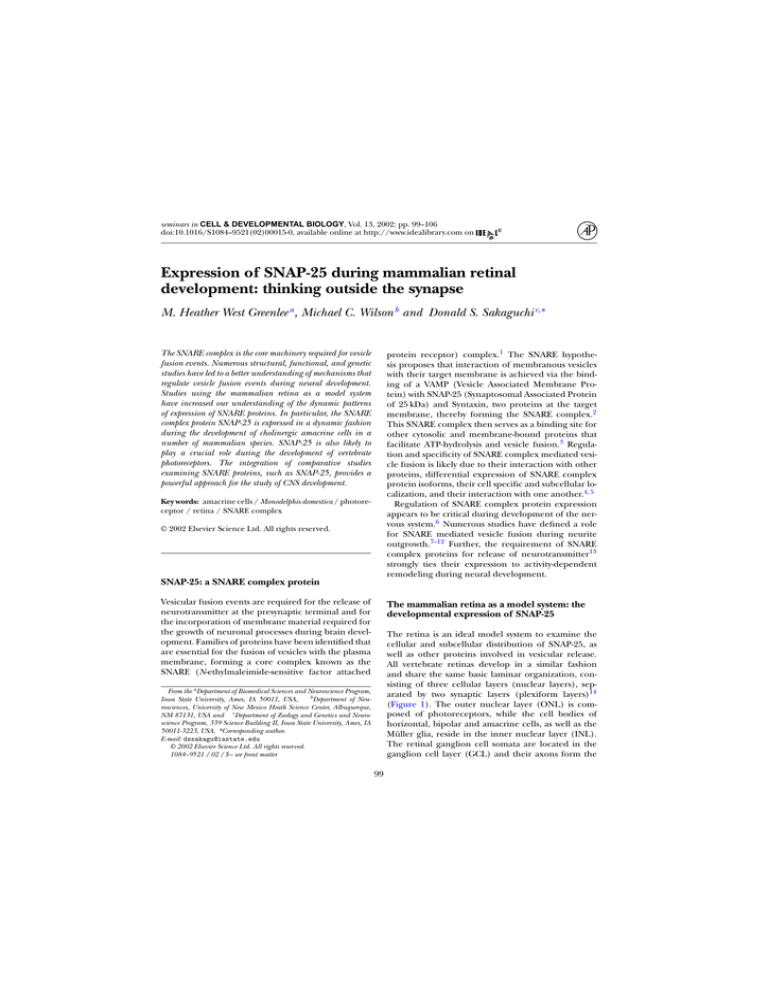
seminars in CELL & DEVELOPMENTAL BIOLOGY, Vol. 13, 2002: pp. 99–106
doi:10.1016/S1084–9521(02)00015-0, available online at http://www.idealibrary.com on
Expression of SNAP-25 during mammalian retinal
development: thinking outside the synapse
M. Heather West Greenlee a , Michael C. Wilson b and Donald S. Sakaguchi c,∗
protein receptor) complex.1 The SNARE hypothesis proposes that interaction of membranous vesicles
with their target membrane is achieved via the binding of a VAMP (Vesicle Associated Membrane Protein) with SNAP-25 (Synaptosomal Associated Protein
of 25 kDa) and Syntaxin, two proteins at the target
membrane, thereby forming the SNARE complex.2
This SNARE complex then serves as a binding site for
other cytosolic and membrane-bound proteins that
facilitate ATP-hydrolysis and vesicle fusion.3 Regulation and specificity of SNARE complex mediated vesicle fusion is likely due to their interaction with other
proteins, differential expression of SNARE complex
protein isoforms, their cell specific and subcellular localization, and their interaction with one another.4, 5
Regulation of SNARE complex protein expression
appears to be critical during development of the nervous system.6 Numerous studies have defined a role
for SNARE mediated vesicle fusion during neurite
outgrowth.7–12 Further, the requirement of SNARE
complex proteins for release of neurotransmitter13
strongly ties their expression to activity-dependent
remodeling during neural development.
The SNARE complex is the core machinery required for vesicle
fusion events. Numerous structural, functional, and genetic
studies have led to a better understanding of mechanisms that
regulate vesicle fusion events during neural development.
Studies using the mammalian retina as a model system
have increased our understanding of the dynamic patterns
of expression of SNARE proteins. In particular, the SNARE
complex protein SNAP-25 is expressed in a dynamic fashion
during the development of cholinergic amacrine cells in a
number of mammalian species. SNAP-25 is also likely to
play a crucial role during the development of vertebrate
photoreceptors. The integration of comparative studies
examining SNARE proteins, such as SNAP-25, provides a
powerful approach for the study of CNS development.
Key words: amacrine cells / Monodelphis domestica / photoreceptor / retina / SNARE complex
© 2002 Elsevier Science Ltd. All rights reserved.
SNAP-25: a SNARE complex protein
Vesicular fusion events are required for the release of
neurotransmitter at the presynaptic terminal and for
the incorporation of membrane material required for
the growth of neuronal processes during brain development. Families of proteins have been identified that
are essential for the fusion of vesicles with the plasma
membrane, forming a core complex known as the
SNARE (N-ethylmaleimide-sensitive factor attached
The mammalian retina as a model system: the
developmental expression of SNAP-25
The retina is an ideal model system to examine the
cellular and subcellular distribution of SNAP-25, as
well as other proteins involved in vesicular release.
All vertebrate retinas develop in a similar fashion
and share the same basic laminar organization, consisting of three cellular layers (nuclear layers), separated by two synaptic layers (plexiform layers)14
(Figure 1). The outer nuclear layer (ONL) is composed of photoreceptors, while the cell bodies of
horizontal, bipolar and amacrine cells, as well as the
Müller glia, reside in the inner nuclear layer (INL).
The retinal ganglion cell somata are located in the
ganglion cell layer (GCL) and their axons form the
From the a Department of Biomedical Sciences and Neuroscience Program,
b Department of NeuIowa State University, Ames, IA 50011, USA,
rosciences, University of New Mexico Heath Science Center, Albuquerque,
NM 87131, USA and c Department of Zoology and Genetics and Neuroscience Program, 339 Science Building II, Iowa State University, Ames, IA
50011-3223, USA. *Corresponding author.
E-mail: dssakagu@iastate.edu
© 2002 Elsevier Science Ltd. All rights reserved.
1084–9521 / 02 / $– see front matter
99
M.H.W. Greenlee et al.
Figure 1. Summary of developmental events in the mammalian retina. This summary diagram illustrates the relative relationships of a number of developmental events in the retina and is based on studies from a variety of mammalian species
including the Brazilian opossum,30, 52 (Sakaguchi, manuscript in preparation), mouse (Wang et al., manuscript in preparation), rat,57 ferret,58, 59 and cat60 . Additional information was obtained from Darlington and colleagues.61 The horizontal
axis represents relative developmental time with respect to conception and the approximate time of eye opening. Black dots
correspond to the approximate time when that particular event first appears. Elongated ovals represent the approximate
timing of neurogenesis (for RGC, HC, PR, AC, BC) and gliogenesis (for MC). The image on the left is a section of a mature
retina and the developmental events on the right are aligned with the appropriate retinal architecture. Abbreviations: RPE:
retinal pigment epithelium; OS: outer segments; ONL: outer nuclear layer; OPL: outer plexiform layer; INL: inner nuclear
layer; IPL: inner plexiform layer, GCL: ganglion cell layer; OFL: optic fiber layer; PR: photoreceptors; HC: horizontal cells;
MC: Müller cells; BC: bipolar cells; AC: amacrine cells; RGC: retinal ganglion cells.
expressed in ribbon synapses.22 This synaptic diversity and characteristic development has made the
mammalian retina an excellent model to study the
expression and localization of SNARE complex
proteins.22–28
The study of SNARE complex protein expression
in the retina provides a useful mean to compare retinal development between mammalian species. There
are a number of species including a range of marsupials, mice, rats, rabbits, ferrets, cats, and primates
that serve as model systems for visual system research.
Studying patterns of SNARE complex protein expression provides a useful approach to evaluate in vivo
and in vitro retinal development as well as the effects
optic fiber layer (OFL), which also contains astrocytes. For each neuronal cell class, there exist multiple
subtypes. Amacrine cells are the most diverse, with
over 20 subtypes thus far identified based on their
neurotransmitter15 or morphology.16 Each amacrine
cell subtype has a distinctive arborization pattern of
processes in the inner plexiform layer (IPL), for example, cholinergic, or starburst amacrine cells arborize
in sublamina 2 and 4 of the IPL.17 Three morphologically different types of synapses are found within
the plexiform layers, conventional,18 ribbon,19, 20
and non-vesicular.21 SNAP-25 and VAMP-2 appear to
function at all retinal synapses, while Syntaxin 1 is
expressed in conventional synapses and Syntaxin 3 is
100
Expression of SNAP-25 during mammalian retinal development: thinking outside the synapse
of experimental manipulation.27, 29 As the developmental functions for SNARE complex proteins continue to be elucidated, it is likely that many SNARE
protein isoforms will exhibit transient patterns of
expression, consistent with specific developmental
roles. For example, we, as well as others, have characterized transient high levels of SNAP-25 expression in
developing cholinergic amacrine cells in the Brazilian
opossum,30, 31 rat,27 and mouse (Wang, Frishman and
Sherry, personal communication) retinas. Depending
on the duration of specific developmental events such
as this, and the function of individual proteins, brief
transient changes in levels of expression could be
‘missed’ in conventional model systems. Previously,
we have taken advantage of the protracted period of
postnatal retinal development in the Brazilian opossum, Monodelphis domestica31–33 to characterize the
changes in SNARE complex protein expression with
greater temporal resolution. At birth, the Monodelphis
retina is a relatively undifferentiated neuroepithelium
with the earliest differentiating ganglion cells located
in the dorso-central retina.31 Eye opening occurs
around 35 days postnatal (35PN). Their immaturity at
birth and their protracted period of postnatal development makes marsupials, like Monodelphis, excellent
models for the study of visual system development.34
tial for the normal development of the mammalian
visual system.37–40 Transient high levels of SNAP-25
expression in these cells, therefore, temporally correlates with their period of participation in spontaneous
retinal waves. This suggests that the regulation of
SNARE protein expression and consequently vesicular release processes underlying neural activity may
be instrumental for retinal development.
Prior to eye opening and normal visual stimulation,
spontaneous waves of correlated activity are present in
the developing mammalian retina.37, 41 This spontaneous retinal activity appears to consist of two phases:
an early cholinergic-dependent phase and a later
glutamatergic-dependent phase.42, 43 Blocking the
cholinergic mediated spontaneous activity prevents
the normal segregation of retinal ganglion cell axons
into their appropriate eye-specific layers within the
lateral geniculate nucleus of the thalamus.38, 39 Retinal activity prior to visual stimulation is important not
only for refinement of the visual projection but also
for the establishment of appropriate circuitry within
the retina itself. In the developing turtle retina, for example, blocking cholinergic-dependent retinal activity results in abnormally large ganglion cell receptive
fields.44 In the mouse retina, cholinergic-dependent
activity plays a limited role in the segregation of retinal ganglion cell dendrites into ON and OFF strata of
the IPL.38 The involvement of cholinergic amacrine
cells in spontaneous retinal activity may be facilitated
by their relatively large, expansive arborizations that
might allow communication of a single amacrine cell
with many ganglion cells and other amacrine cells, via
both chemical and electrical synapses.45
The cholinergic-dependent spontaneous activity
observed during the early development of the visual system may, in part, be regulated by differential
expression of proteins that comprise the synaptic
machinery necessary for regulated neurotransmitter
release. SNAP-25 is crucial for regulated exocytosis
of neurotransmitter.3, 46 Although, SNAP-25 is clearly
not essential for axonal innervation and initial synapse
formation at neuromuscular junctions and in brain,
earlier studies have implicated that this SNARE could
play some role in the events that accompany the development of synaptic connectivity.8, 47 The transient,
high levels of SNAP-25 in cholinergic amacrine cells
may represent a critical period for the selective enhancement of synaptic machinery in these neurons.
Increased abundance of SNAP-25 may serve to facilitate the interaction of a large number of synaptic vesicles with the presynaptic terminal membrane, thereby
increasing the likelihood of transmitter release.
Examples of cell-specific regulation of
SNAP-25 in the developing mammalian retina
Transient high levels of SNAP-25 in cholinergic
amacrine cells
Developing cholinergic amacrine cells, identified
using an anti-choline-acetyl transferase (ChAT)
antibody35 transiently exhibit high levels of SNAP-25
immunoreactivity prior to eye opening27, 30, 31 (Wang,
Frishman and Sherry, personal communication)
(Figure 1). In the developing opossum retina, high
levels of SNAP-25 expression parallel the onset of
ChAT expression (Figure 2). Initially, all cholinergic
amacrine cells are highly SNAP-25 immunoreactive,
but as development proceeds, many cholinergic cells
downregulate SNAP-25 expression, such that by eye
opening, the majority have basal levels of SNAP-25
expression similar to surrounding cells (Figures 1
and 2). In situ hybridization studies suggest this decrease in SNAP-25 protein is regulated post-translationally.36 The cholinergic amacrine cells appear to
play a critical role in the generation and propagation
of spontaneous waves of retinal activity that is essen101
Figure 2. Transient high levels of SNAP-25 expression in developing cholinergic amacrine cells. Choline acetyltransferase-IR
was first detected in the 15PN Monodelphis retina (A) shortly after high levels of SNAP-25-IR were first observed (B). In the
25PN retina, ChAT-IR (C) and SNAP-25-IR (D) were present in the same cells and processes in the IPL. At 35PN, just prior to
eye opening, the distinctive pattern of ChAT-IR (E) in cell bodies and processes was evident, while high levels of SNAP-25-IR
(F) in cell bodies were greatly diminished, though the bilaminar immunoreactivity in the IPL was still present. In the adult
retina, ChAT-IR displayed its characteristic pattern (G), while SNAP-25-IR was now diffuse throughout the IPL and essentially
absent from cell bodies (H). The graph represents the average number of ChAT-immunoreactive cell bodies and the average
number of highly SNAP-25-immunoreactive cell bodies per section of retina from each age examined. The horizontal axis
represents the ages examined and the vertical axis represents the average number of highly SNAP-25-immunoreactive or
ChAT-immunoreactive cell bodies per section. The arrowheads pointing to dark, horizontal lines, represent the average
number of double-labeled cells per section. Error bars represent SEM. Sample sizes for each age are as follows: 20PN (n = 12
sections from four eyes (12/4)); 25PN (n = 17/6); 30PN (n = 15/5); 35PN (n = 9/3); Adult (n = 6/2). Abbreviations:
GCL: ganglion cell layer; IPL: inner plexiform layer; INL: inner nuclear layer. Scale bar = 20 µm.
102
Expression of SNAP-25 during mammalian retinal development: thinking outside the synapse
at the photoreceptor synapse,22 SNAP-25 in photoreceptors may play an integral role in the fusion of
rhodopsin-containing vesicles with the inner segment
membrane, which may in turn supply membrane
for outer segment disc formation. This hypothesis is
supported by reports that C-terminal mutations in
rhodopsin resulting in its aberrant subcellular localization result in degeneration of photoreceptor outer
segments.50, 51
Recent study of SNAP-25 null mutant mice has provided additional insight into the role for SNAP-25
in developing photoreceptors.52 Homozygous null
(−/−) mice express no SNAP-25, while heterozygotes (−/+) express approximately 50% of SNAP-25
as compared to wild-type (wt) animals.46 Retinae
of heterozygotes were examined by immunostaining for the protein recoverin53 which can be used
as an early marker for photoreceptors in the developing retina. Mice, expressing 50% of normal
SNAP-25 levels (−/+), have an average of 33% more
recoverin-immunoreactive cells than wt littermates at
embryonic ages (Figure 4). This suggests that mice
with a lower level of SNAP-25 expression exhibit an
Thus, the period of high SNAP-25 expression in
cholinergic amacrine cells may represent a period of
extensive synaptogenesis and/or synaptic plasticity
for these cells.
High levels of SNAP-25 expression in photoreceptors
High levels of SNAP-25 expression have been observed in developing photoreceptors of the Brazilian
opossum,31, 33 rat,27, 33 ferret,24 and mouse (Wang,
Frishman and Sherry, personal communication and
manuscript in preparation) retinas (Figure 3). In the
adult retina, high levels of SNAP-25 in photoreceptors are primarily localized to synaptic regions and
inner segments.27, 33 Photoreceptors are in a perpetual state of membrane shedding and renewal. This
is the result of the continual addition of membranous discs to the base of the outer segment, which
is necessary for maintenance of the outer segment,
as outer segment membrane is lost when effete
discs are regularly shed from the tip of the outer
segment and phagocytized by the retinal pigment
epithelium.48, 49 In addition to its synaptic function
Figure 3. High levels of SNAP-25 are expressed in developing photoreceptors. During early retinal development, in the
15PN Monodelphis retina, high levels of SNAP-25 were present in most cells in the outer retina, while recoverin-IR was observed
in only a few cells in the outer retina (A and B). Merging the two images demonstrates that these recoverin-IR cells were also
SNAP-25-immunoreacitive (C, arrows). Just prior to eye opening, at 35PN in the Monodelphis retina, the vast majority of ONL
cells were immunoreactive for SNAP-25 and recoverin (D and E). Merging images D and E demonstrates co-localization of
SNAP-25 and recoverin-IRs (F). Abbreviations: PN: days postnatal; OPL: outer plexiform layer; ONL: outer nuclear layer.
Scale bars: A–C = 10 µm, D–E = 20 µm.
103
M.H.W. Greenlee et al.
Figure 4. Normal levels of SNAP-25 expression in the developing retina are crucial for appropriate photoreceptor differentiation. Transgenic mice heterozygous for the SNAP-25 null mutation display 50% of normal levels of SNAP-25 expression.
Recoverin-immunoreactivity identifies differentiating photoreceptors in the E16.5 wt retina (A). In a heterozygous littermate,
the density of recoverin-immunoreactive cells is much higher (B). Within a given litter, the heterozygotes have an average of
33% more recoverin-immunoreactive cells compared to their wild type littermates. Abbreviations: (+/+): wild-type; (−/+):
heterozygote; RPE: retinal pigment epithelium. Scale bar = 20 µm.
increase in photoreceptor differentiation during this
early period of retinal development (manuscript in
preparation). In addition, preliminary functional
studies of juvenile heterozygote retinas suggest an
increase in cone function. Taken together, these data
suggest that SNAP-25 regulation in developing photoreceptors is important for appropriate photoreceptor differentiation. Furthermore, decreased SNAP-25
expression in the photoreceptors of the hetrozygotes
may somehow favor cone development. This effect
may be due to a decrease in vesicular release of a
factor that normally suppresses photoreceptor differentiation during embryonic retinal development.54, 55
Cells of the embryonic retina also express cell surface
receptors for factors that inhibit differentiation of
photoreceptors. For example, the Delta–Notch signaling pathway acts to inhibit differentiation of retinal
progenitor cells.56 These receptors may be exposed
to the cell surface via fusion of a receptor-containing
vesicle with the plasma membrane. A decrease in
SNAP-25 expression might then decrease the fusion
of these receptor-containing vesicles, and effectively
reduce the signaling via such an inhibitory pathway.
While the precise effect of a decrease in SNAP-25 expression in the developing retina is still under investigation, it seems clear that high levels of SNAP-25 in
the developing retina are critical for the appropriate
differentiation of photoreceptors.
Conclusions
SNARE complex proteins play critical roles during
regulated vesicular release of neurotransmitter. Furthermore, they have important roles during neurite
outgrowth and synaptogenesis. The spatiotemporal
localization of SNARE complex proteins provides new
criteria for the comparison of retinal development
between mammalian species and to evaluate retinal
development in vitro or within other experimental
paradigms including transgenic animals.
This review has discussed the differential expression of SNAP-25 in two specific cell types within the
mammalian retina. During development, spontaneous waves of activity drives the segregation of retinal ganglion cell axons into eye specific lamina in the
lateral geniculate nucleus. The transient high level
of SNAP-25 expression in cholinergic amacrine cells
correlates with their participation in spontaneous
retinal activity. While a direct functional correlation
has not yet been established, the developing retina
may provide an exceptional opportunity to study
the functional effect of an increase in expression of
vesicular release machinery. High levels of SNAP-25
in photoreceptors may serve two distinct functions.
High levels of SNAP-25 in the photoreceptor inner
segment suggest SNAP-25 may play a crucial role in
fusion of rhodopsin-containing vesicles with the inner
104
Expression of SNAP-25 during mammalian retinal development: thinking outside the synapse
segment membrane. High levels of SNAP-25 in photoreceptors during development, however, appear to
function at some point during cell fate determination
and therefore may be important for photoreceptor
differentiation. It is clear that the characterization of
SNAP-25 expression in the developing retina may afford additional opportunity for the study of SNAP-25
function ‘outside the synapse’. For example, one particularly intriguing question is whether the activation
of the protein machinery mediating these developmental events is, like synchronous neurotransmission
required for synaptic communication, dependent
on membrane depolarization and calcium influx.
Ongoing and future studies examining the dynamic
patterns of SNAP-25, as well as other SNARE complex proteins in the retina and their relationship to
activity-dependent synaptic plasticity and cellular differentiation, will likely provide invaluable information
relevant to mammalian CNS development.
10.
11.
12.
13.
14.
15.
16.
Acknowledgements
17.
The authors wish to thank David M. Sherry, M. Wang,
and L. J. Frishman for sharing their unpublished work
in the mouse retina. The authors have been supported
by Grants from the NSF, NIH, the Iowa State University
Biotechnology Council, and the Carver Trust.
18.
19.
20.
References
21.
1. Sollner T, Whiteheart SW, Brunner M, Erdjument-Bromage H,
Geromanos S, Tempst P, Rothman JE (1993) SNAP receptors
implicated in vesicle targeting and fusion [see comments]. Nature 362:318–324
2. Rothman JE, Warren G (1994) Implications of the SNARE hypothesis for intracellular membrane topology and dynamics.
Curr Biol 4:220–233
3. Calakos N, Scheller RH (1996) Synaptic vesicle biogenesis, docking, and fusion: a molecular description. Physiol Rev 76:1–29
4. Chen YA, Scheller RH (2001) SNARE-mediated membrane fusion. Nat Rev Mol Cell Biol 2:98–106
5. Gerst JE (1999) SNAREs and SNARE regulators in membrane
fusion and exocytosis. Cell Mol Life Sci 55:707–734
6. Hepp R, Langley K (2001) SNAREs during development. Cell
Tissue Res 305:247–253
7. Osen-Sand A, Catsicas M, Staple JK, Jones KA, Ayala G, Knowles
J, Grenningloh G, Catsicas S (1993) Inhibition of axonal growth
by SNAP-25 antisense oligonucleotides in vitro and in vivo [see
comments]. Nature 364:445–448
8. Osen-Sand A, Staple JK, Naldi E, Schiavo G, Rossetto O, Petitpierre S, Malgaroli A, Montecucco C, Catsicas S (1996) Common and distinct fusion proteins in axonal growth and transmitter release. J Comp Neurol 367:222–234
9. Igarashi M, Kozaki S, Terakawa S, Kawano S, Ide C, Komiya Y
(1996) Growth cone collapse and inhibition of neurite growth
22.
23.
24.
25.
26.
27.
28.
105
by Botulinum neurotoxin C1: a t-SNARE is involved in axonal
growth. J Cell Biol 134:205–215
Igarashi M, Tagaya M, Komiya Y (1997) The soluble
N-ethylmaleimide-sensitive factor attached protein receptor
complex in growth cones: molecular aspects of the axon terminal development. J Neurosci 17:1460–1470
Zhou Q, Xiao J, Liu Y (2000) Participation of syntaxin 1A in
membrane trafficking involving neurite elongation and membrane expansion. J Neurosci Res 61:321–328
Martinez-Arca S, Coco S, Mainguy G, Schenk U, Alberts P,
Bouille P, Mezzina M, Prochiantz A, Matteoli M, Louvard D,
Galli T (2001) A common exocytotic mechanism mediates axonal and dendritic outgrowth. J Neurosci 21:3830–3838
Schiavo G, Matteoli M, Montecucco C (2000) Neurotoxins affecting neuroexocytosis. Physiol Rev 80:717–766
Rodieck RW (1973) The vertebrate retina: principals of structure and function Structure: Survey. pp. 1–10. WH Freeman,
San Francisco
Masland RH (1996) Processing and encoding of visual information in the retina. Curr Opin Neurobiol 6:467–474
MacNeil MA, Heussy JK, Dacheux RF, Raviola E, Masland RH
(1999) The shapes and numbers of amacrine cells: matching
of photofilled with golgi-stained cells in the rabbit retina and
comparison with other mammalian species. J Comp Neurol
413:305–326
Famiglietti EV (1983) On and off pathways through amacrine
cells in mammalian retina: the synaptic connections of starburst
amacrine cells. Vision Res 23:1265–1279
Mandell JW, Townes-Anderson E, Czernik AJ, Cameron R,
Greengard P, De Camilli P (1990) Synapsins in the vertebrate
retina: absence from ribbon synapses and heterogeneous distribution among conventional synapses. Neuron 5:19–33
Sjöstrand F (1953) Ultrastructure of the outer segments of the
rods and cones of the eye as revealed by the electron microscope. Cell Comp Physiol 42:15–44
Kidd M (1962) Electron microscopy of the inner plexiform layer
of the retina of the cat and pigeon. J Anat 96:179–188
Schwartz EA (1987) Depolarization without calcium can release gamma-aminobutyric acid from a retinal neuron. Science
238:350–355
Morgans CW, Brandstatter JH, Kellerman J, Betz H, Wassle H
(1996) A SNARE complex containing syntaxin 3 is present in
ribbon synapses of the retina. J Neurosci 16:6713–6721
Catsicas S, Catsicas M, Keyser KT, Karten HJ, Wilson MC, Milner RJ (1992) Differential expression of the presynaptic protein
SNAP-25 in mammalian retina. J Neurosci Res 33:1–9
Karne A, Oakley DM, Wong GK, Wong RO (1997) Immunocytochemical localization of GABA, GABAA receptors, and
synapse-associated proteins in the developing and adult ferret
retina. Vis Neurosci 14:1097–1108
Ullrich B, Sudhof TC (1994) Distribution of synaptic markers
in the retina: implications for synaptic vesicle traffic in ribbon
synapses. J Physiol (Paris) 88:249–257
Von Kriegstein K, Schmitz F, Link E, Sudhof TC (1999) Distribution of synaptic vesicle proteins in the mammalian retina identifies obligatory and facultative components of ribbon synapses.
Eur J Neurosci 11:1335–1348
Chen ST, Garey LJ, Jen LS (1998) Immunoreactivity to
synaptosomal-associated protein-25 in developing rat retinas: effects of a glutamate agonist and retinal transplantation to a host
brain. J Hirnforsch 39:253–262
Mulugeta S, Ciavarra RP, Maney RK, Tedeschi B (2000) Three
subpopulations of fast axonally transported retinal ganglion cell
M.H.W. Greenlee et al.
29.
30.
31.
32.
33.
34.
35.
36.
37.
38.
39.
40.
41.
42.
43.
44.
proteins are differentially trafficked in the rat optic pathway. J
Neurosci Res 59:247–258
Wouters BC, Bock-Samson S, Little K, Norden JJ (1998)
Up-regulation of fast-axonally transported proteins in retinal
ganglion cells of adult rats with optic-peroneal nerve grafts.
Brain Res Mol Brain Res 53:53–68
West Greenlee MH, Finley SK, Wilson MC, Jacobson CD, Sakaguchi DS (1998) Transient, high levels of SNAP-25 expression
in cholinergic amacrine cells during postnatal development of
the mammalian retina. J Comp Neurol 394:374–385
West Greenlee MH, Swanson JJ, Simon JJ, Elmquist JK, Jacobson
CD, Sakaguchi DS (1996) Postnatal development and the differential expression of presynaptic terminal-associated proteins
in the developing retina of the Brazilian opossum, Monodelphis
domestica. Dev Brain Res 96:159–172
Kuehl-Kovarik MC, Sakaguchi DS, Iqbal J, Sonea I, Jacobson
CD (1995) The gray short-tailed opossum: a novel model for
mammalian development. Lab Anim 24:24–29
West Greenlee MH, Roosevelt CB, Sakaguchi DS (2001) Differential localization of SNARE complex proteins SNAP-25, syntaxin, and VAMP during development of the mammalian retina.
J Comp Neurol 430:306–320
Mark RF, Marotte LR (1992) Australian marsupials as models
for the developing mammalian visual system. Trends Neurosci
15:51–57
Voigt T (1986) Cholinergic amacrine cells in the rat retina. J
Comp Neurol 248:19–35
West Greenlee MH, Sakaguchi DS (1999) Distribution of
SNAP-25A and SNAP-25B isoforms during development of the
mammalian retina. Ann Meeting Soc Neurosci 25:702–710
Feller MB, Wellis DP, Stellwagen D, Werblin FS, Shatz CJ (1996)
Requirement for cholinergic synaptic transmission in the propagation of spontaneous retinal waves. Science 272:1182–1187
Bansal A, Singer JH, Hwang BJ, Xu W, Beaudet A, Feller MB
(2000) Mice lacking specific nicotinic acetylcholine receptor
subunits exhibit dramatically altered spontaneous activity patterns and reveal a limited role for retinal waves in forming ON
and OFF circuits in the inner retina. J Neurosci 20:7672–7681
Penn AA, Riquelme PA, Feller MB, Shatz CJ (1998) Competition
in retinogeniculate patterning driven by spontaneous activity.
Science 279:2108–2112
Zhou ZJ (1998) Direct participation of starburst amacrine cells
in spontaneous rhythmic activities in the developing mammalian retina. J Neurosci 18:4155–4165
Wong RO, Meister M, Shatz CJ (1993) Transient period of correlated bursting activity during development of the mammalian
retina. Neuron 11:923–938
Zhou ZJ, Zhao D (2000) Coordinated transitions in neurotransmitter systems for the initiation and propagation of spontaneous
retinal waves. J Neurosci 20:6570–6577
Wong WT, Myhr KL, Miller ED, Wong RO (2000) Developmental changes in the neurotransmitter regulation of correlated
spontaneous retinal activity. J Neurosci 20:351–360
Sernagor E, Grzywacz NM (1996) Influence of spontaneous
activity and visual experience on developing retinal receptive
fields. Curr Biol 6:1503–1508
45. Penn AA, Wong RO, Shatz CJ (1994) Neuronal coupling in the
developing mammalian retina. J Neurosci 14:3805–3815
46. Washbourne P, Thompson P, Carta M, Costa E, Mathews J,
Lopez-Bendito G, Molnar Z, Becher M, Valenzuela C, Partridge
L, Wilson M (2002) Genetic ablation of the t-SNARE SNAP-25
distinguishes mechanisms of neuroexocytosis. Nat Neurosci
5:19–26
47. Catsicas S, Larhammar D, Blomqvist A, Sanna PP, Milner RJ,
Wilson MC (1991) Expression of a conserved cell-type-specific
protein in nerve terminals coincides with synaptogenesis. Proc
Natl Acad Sci USA 88:785–789
48. Anderson DH, Fisher SK, Steinberg RH (1978) Mammalian
cones: disc shedding, phagocytosis, and renewal. Invest Ophthalmol Vis Sci 17:117–133
49. Matsumoto B, Defoe DM, Besharse JC (1987) Membrane
turnover in rod photoreceptors: ensheathment and phagocytosis of outer segment distal tips by pseudopodia of the retinal pigment epithelium. Proc R Soc Lond B Biol Sci 230:339–
354
50. Deretic D (1998) Post-golgi trafficking of rhodopsin in retinal
photoreceptors. Eye 12:526–530
51. Deretic D, Schmerl S, Hargrave PA, Arendt A, McDowell
JH (1998) Regulation of sorting and post-golgi trafficking of
rhodopsin by its C-terminal sequence QVS(A)PA. Proc Natl
Acad Sci USA 95:10620–10625
52. West Greenlee M, Sakaguchi D, Wilson M (2001) High levels
of SNAP-25 expression are required for normal photoreceptor
differentiation and development. Ann Meeting Soc Neurosci
27:252–255
53. Dizhoor AM, Ray S, Kumar S, Niemi G, Spencer M, Brolley D,
Walsh KA, Philipov PP, Hurley JB, Stryer L (1991) Recoverin:
a calcium sensitive activator of retinal rod guanylate cyclase.
Science 251:915–918
54. Levine EM, Fuhrmann S, Reh TA (2000) Soluble factors and the
development of rod photoreceptors. Cell Mol Life Sci 57:224–
234
55. Livesey FJ, Cepko CL (2001) Vertebrate neural cell-fate determination: lessons from the retina. Nat Rev Neurosci 2:109–
118
56. Rapaport DH, Dorsky RI (1998) Inductive competence, its
significance in retinal cell fate determination and a role for
Delta–Notch signaling. Semin Cell Dev Biol 9:241–247
57. Weidman TA, Kuwabara T (1968) Postnatal development of the
rat retina. Arch Ophthal 79:470–484
58. Greiner JV, Weidman TA (1981) Histogenesis of the ferret
retina. Exp Eye Res 33:315–332
59. Wong RO (1999) Retinal waves and visual system development.
Annu Rev Neurosci 22:29–47
60. Polley EH, Zimmerman RP, Fortney RL (1989) Neurogenesis
and maturation of cell morphology in the development of the
mammalian retina (Finlay BL, Sengelaub DR, eds) Development of the Vertebrate Retina, pp. 3–29. Plenum Press, New
York and London
61. Darlington RB, Dunlop SA, Finlay BL (1999) Neural development in metatherian and eutherian mammals: variation and
constraint. J Comp Neurol 411:359–368
106



